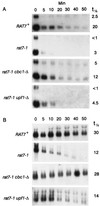The role of nuclear cap binding protein Cbc1p of yeast in mRNA termination and degradation
- PMID: 10733586
- PMCID: PMC85501
- DOI: 10.1128/MCB.20.8.2827-2838.2000
The role of nuclear cap binding protein Cbc1p of yeast in mRNA termination and degradation
Abstract
The cyc1-512 mutation in Saccharomyces cerevisiae causes a 90% reduction in the level of iso-1-cytochrome c because of the lack of a proper 3'-end-forming signal, resulting in low levels of eight aberrantly long cyc1-512 mRNAs which differ in length at their 3' termini. cyc1-512 can be suppressed by deletion of either of the nonessential genes CBC1 and CBC2, which encode the CBP80 and CBP20 subunits of the nuclear cap binding complex, respectively, or by deletion of the nonessential gene UPF1, which encodes a major component of the mRNA surveillance complex. The upf1-Delta deletion suppressed the cyc1-512 defect by diminishing degradation of the longer subset of cyc1-512 mRNAs, suggesting that downstream elements or structures occurred in the extended 3' region, similar to the downstream elements exposed by transcripts bearing premature nonsense mutations. On the other hand, suppression of cyc1-512 defects by cbc1-Delta occurred by two different mechanisms. The levels of the shorter cyc1-512 transcripts were enhanced in the cbc1-Delta mutants by promoting 3'-end formation at otherwise-weak sites, whereas the levels of the longer cyc1-512 transcripts, as well as of all mRNAs, were slightly enhanced by diminishing degradation. Furthermore, cbc1-Delta greatly suppressed the degradation of mRNAs and other phenotypes of a rat7-1 strain which is defective in mRNA export. We suggest that Cbc1p defines a novel degradation pathway that acts on mRNAs partially retained in nuclei.
Figures









References
-
- Amberg D C, Goldstein L A, Cole C N. Isolation and characterization of RAT1: an essential gene of Saccharomyces cerevisiae required for the efficient nucleocytoplasmic trafficking of mRNA. Genes Dev. 1992;6:1173–1189. - PubMed
-
- Atkin A L, Schenkman L R, Eastham M, Dahlseid J N, Lelivelt M J, Culbertson M R. Relationship between yeast polyribosomes and Upf proteins required for nonsense mRNA decay. J Biol Chem. 1997;272:22163–22172. - PubMed
Publication types
MeSH terms
Substances
Grants and funding
LinkOut - more resources
Full Text Sources
Molecular Biology Databases
Miscellaneous
